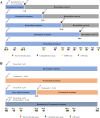An In Silico Platform to Predict Cardiotoxicity Risk of Anti-tumor Drug Combination with hiPSC-CMs Based In Vitro Study
- PMID: 38148384
- PMCID: PMC10879352
- DOI: 10.1007/s11095-023-03644-4
An In Silico Platform to Predict Cardiotoxicity Risk of Anti-tumor Drug Combination with hiPSC-CMs Based In Vitro Study
Abstract
Objective: Antineoplastic agent-induced systolic dysfunction is a major reason for interruption of anticancer treatment. Although targeted anticancer agents infrequently cause systolic dysfunction, their combinations with chemotherapies remarkably increase the incidence. Human induced pluripotent stem cell-derived cardiomyocytes (hiPSC-CMs) provide a potent in vitro model to assess cardiovascular safety. However, quantitatively predicting the reduction of ejection fraction based on hiPSC-CMs is challenging due to the absence of the body's regulatory response to cardiomyocyte injury.
Methods: Here, we developed and validated an in vitro-in vivo translational platform to assess the reduction of ejection fraction induced by antineoplastic drugs based on hiPSC-CMs. The translational platform integrates drug exposure, drug-cardiomyocyte interaction, and systemic response. The drug-cardiomyocyte interaction was implemented as a mechanism-based toxicodynamic (TD) model, which was then integrated into a quantitative system pharmacology-physiological-based pharmacokinetics (QSP-PBPK) model to form a complete translational platform. The platform was validated by comparing the model-predicted and clinically observed incidence of doxorubicin and trastuzumab-induced systolic dysfunction.
Results: A total of 33,418 virtual patients were incorporated to receive doxorubicin and trastuzumab alone or in combination. For doxorubicin, the QSP-PBPK-TD model successfully captured the overall trend of systolic dysfunction incidences against the cumulative doses. For trastuzumab, the predicted incidence interval was 0.31-2.7% for single-agent treatment and 0.15-10% for trastuzumab-doxorubicin sequential treatment, covering the observations in clinical reports (0.50-1.0% and 1.5-8.3%, respectively).
Conclusions: In conclusion, the in vitro-in vivo translational platform is capable of predicting systolic dysfunction incidence almost merely depend on hiPSC-CMs, which could facilitate optimizing the treatment protocol of antineoplastic agents.
Keywords: cancer therapy; cardiac toxicity; in vitro to in vivo translation; pluripotent stem cells; quantitative systems pharmacology.
© 2023. The Author(s).
Conflict of interest statement
The authors declare no conflict of interest. The funders had no role in the design of the study; in the collection, analyses, or interpretation of data; in the writing of the manuscript, or in the decision to publish the results.
Figures







Similar articles
-
GATA4-targeted compound exhibits cardioprotective actions against doxorubicin-induced toxicity in vitro and in vivo: establishment of a chronic cardiotoxicity model using human iPSC-derived cardiomyocytes.Arch Toxicol. 2020 Jun;94(6):2113-2130. doi: 10.1007/s00204-020-02711-8. Epub 2020 Mar 17. Arch Toxicol. 2020. PMID: 32185414 Free PMC article.
-
Development of In Vitro Drug-Induced Cardiotoxicity Assay by Using Three-Dimensional Cardiac Tissues Derived from Human Induced Pluripotent Stem Cells.Tissue Eng Part C Methods. 2018 Jan;24(1):56-67. doi: 10.1089/ten.TEC.2017.0247. Epub 2017 Nov 17. Tissue Eng Part C Methods. 2018. PMID: 28967302 Free PMC article.
-
Multiscale and Translational Quantitative Systems Toxicology, Pharmacokinetic-Toxicodynamic Modeling Analysis for Assessment of Doxorubicin-Induced Cardiotoxicity.AAPS J. 2021 Jan 6;23(1):18. doi: 10.1208/s12248-020-00542-0. AAPS J. 2021. PMID: 33404976
-
[Prediction of Cardiac Toxicity by Anti-cancer Drugs Using iPSC Cardiomyocytes].Yakugaku Zasshi. 2024;144(3):265-271. doi: 10.1248/yakushi.23-00164-3. Yakugaku Zasshi. 2024. PMID: 38432935 Review. Japanese.
-
Moving beyond the comprehensive in vitro proarrhythmia assay: Use of human-induced pluripotent stem cell-derived cardiomyocytes to assess contractile effects associated with drug-induced structural cardiotoxicity.J Appl Toxicol. 2018 Sep;38(9):1166-1176. doi: 10.1002/jat.3611. Epub 2018 Feb 27. J Appl Toxicol. 2018. PMID: 29484688 Review.
Cited by
-
Pharmacokinetics-Pharmacodynamics Modeling for Evaluating Drug-Drug Interactions in Polypharmacy: Development and Challenges.Clin Pharmacokinet. 2024 Jul;63(7):919-944. doi: 10.1007/s40262-024-01391-2. Epub 2024 Jun 18. Clin Pharmacokinet. 2024. PMID: 38888813 Review.
-
Bridging the Gap Between hiPSC-CMs Cardiotoxicity Assessment and Clinical LVEF Decline Risk: A Case Study of 21 Tyrosine Kinase Inhibitors.Pharmaceuticals (Basel). 2025 Mar 23;18(4):450. doi: 10.3390/ph18040450. Pharmaceuticals (Basel). 2025. PMID: 40283889 Free PMC article.
-
A Systematic Review of the Cardiotoxic Effects of Targeted Therapies in Oncology.Cureus. 2024 Aug 6;16(8):e66258. doi: 10.7759/cureus.66258. eCollection 2024 Aug. Cureus. 2024. PMID: 39238728 Free PMC article. Review.
-
Update on preclinical models of cancer therapy-related cardiac dysfunction: Challenges and perspectives. A scientific statement of the Heart Failure Association (HFA) of the ESC, the ESC Council of Cardio-Oncology, and the ESC Working Group on Cellular Biology of the Heart.Eur J Heart Fail. 2025 Jun;27(6):1028-1046. doi: 10.1002/ejhf.3636. Epub 2025 Mar 11. Eur J Heart Fail. 2025. PMID: 40069106 Free PMC article. Review.
References
-
- Krop IE, Kim SB, Gonzalez-Martin A, LoRusso PM, Ferrero JM, Smitt M, et al. Trastuzumab emtansine versus treatment of physician’s choice for pretreated HER2-positive advanced breast cancer (TH3RESA): a randomised, open-label, phase 3 trial. Lancet Oncol. 2014;15(7):689–99. - PubMed
MeSH terms
Substances
Grants and funding
LinkOut - more resources
Full Text Sources

